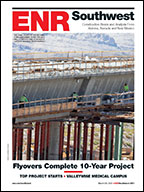
The Chinese government says its contractors are on schedule to complete this month the first phase of the $62-billion South-North Water Diversion Project. Originally proposed by Chairman Mao Zedong in 1952, the SNWDP is a large-scale water-transfer project that will convey water from the Yangtze River and its tributaries in southern China to the Yellow and Hai rivers in the water-stressed and heavily populated North China Plain.
The environmentally controversial scheme is designed to provide water to approximately a quarter of China’s 1.3 billion people, including inhabitants of the Beijing and Tianjin megacities. The SNWDP comprises eastern, central and western routes, each of which will feature an extensive network of open-water channels, pumping stations and tunneling systems that ultimately would transfer 44.8 billion cubic meters of water per year.
After decades of planning, the project was officially launched in 2002, when work started on the eastern route; central-route construction commenced the following year. Earlier this year, the China State Council South-to-North Water Diversion Office reported the first stage of the eastern route will be complete this year. Once in operation, the segment will deliver 14.8 billion cu m of water annually to reservoirs near Tianjin. Next, the central route is scheduled to divert 13 billion cu m of water per year to Beijing from the Danjiangkou Reservoir on the Han River, a tributary of the Yangtze.
The western route, which would transfer water from the headwaters of the Yangtze River to the headwaters of the Yellow River, necessitates overcoming a number of environmental and engineering challenges associated with navigating the high-elevation Qinghai-Tibet Plateau and tunneling through sections of the Bayankala Mountains. The route is still in the design stage. At project completion, the combined total length of conveyance for all three routes would be 1,781 miles.
Drivers
The project is being developed in response to increasingly severe water shortages in North China Plain (NCP) cities as years of booming population growth, urban development and industrialization have led to the rapid depletion of water resources, including aquifers of the NCP, the region’s primary water-supply source.
Richard Evans, principal hydrogeologist with Sinclair Knight Merz in Australia and a consultant to China’s Ministry of Water Resources, said China’s northern cities have been forced to ration water following decades of groundwater overuse. “Most of the groundwater overdevelopment in the region is attributed to high levels of irrigation, driven by the need for food security,” Evans said. “In some locations, the aquifers are completely dry.”
Evans, who is working on a water management project funded jointly by the World Bank and the Ministry of Water Resources, said many factors are driving the SNWDP, but the primary one is rapid urban development. “Cities in the NCP are growing at a tremendous rate, with some 30 million people every year moving from the countryside to urban centers, putting huge stresses on local water supplies,” he said. “The SNWDP will import a high volume of water for augmenting the urban supply but will not necessarily address the primary issue related to overuse of the groundwater systems for irrigation.”
Controversies
As with other Chinese megaprojects, a number of concerns have been raised in relation to the SNWDP's environmental and social impacts.
Britt Crow—a Ph.D. candidate whose research focuses on water and development in contemporary China—said the project’s central and eastern routes have forced the relocation of several hundred thousand people. “Many of those who have been relocated were either fishermen or farmers who no longer have access to either fish or land and are instead turning to jobs in local factories or migrating to distant cities,” said Crow, who studies in the University of California, Los Angeles, geography department.
Water pollution is another significant issue. “Much of the water being transferred northward is already dangerously polluted, forcing the government to construct numerous water treatment facilities along the routes, particularly the eastern route,” Crow said. “This has made the cost of transferred water much higher than originally anticipated—even more expensive than desalinated water, in some cases.”
The SNWDP's real problem is that it is not actually a solution to northern China’s water issues, according to Crow. “The project does not represent a long-term strategy for dealing with the sources of water stress in cities like Beijing,” she said. “Rather, it allows them to continue on a fundamentally unsustainable trajectory while the underlying situation continues to worsen.”



Post a comment to this article
Report Abusive Comment